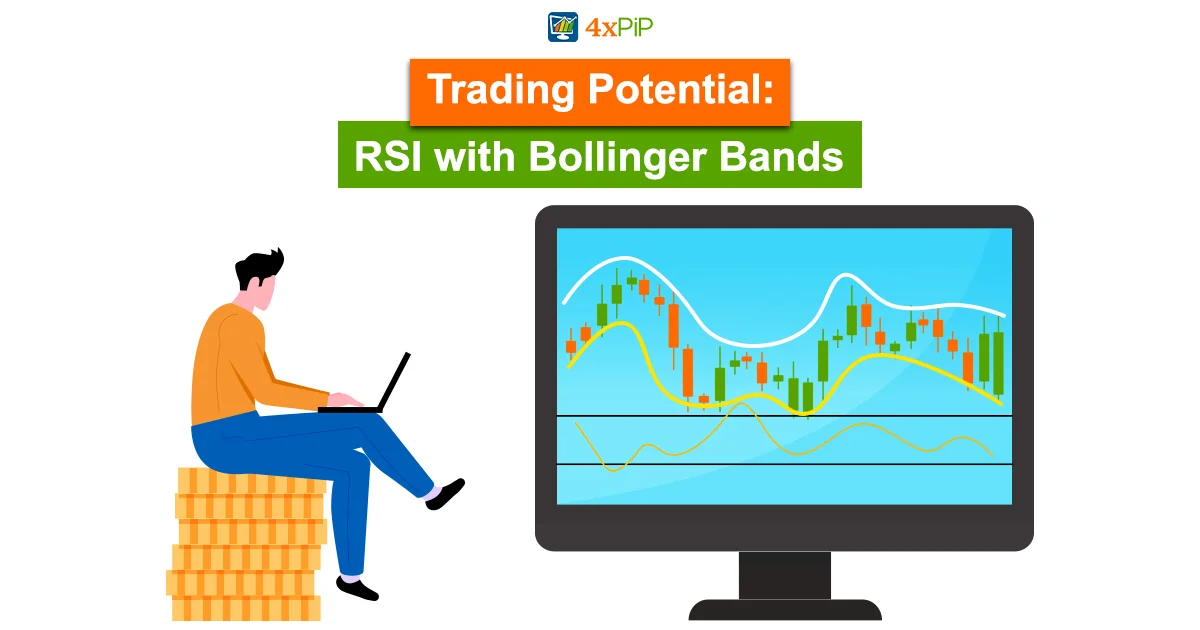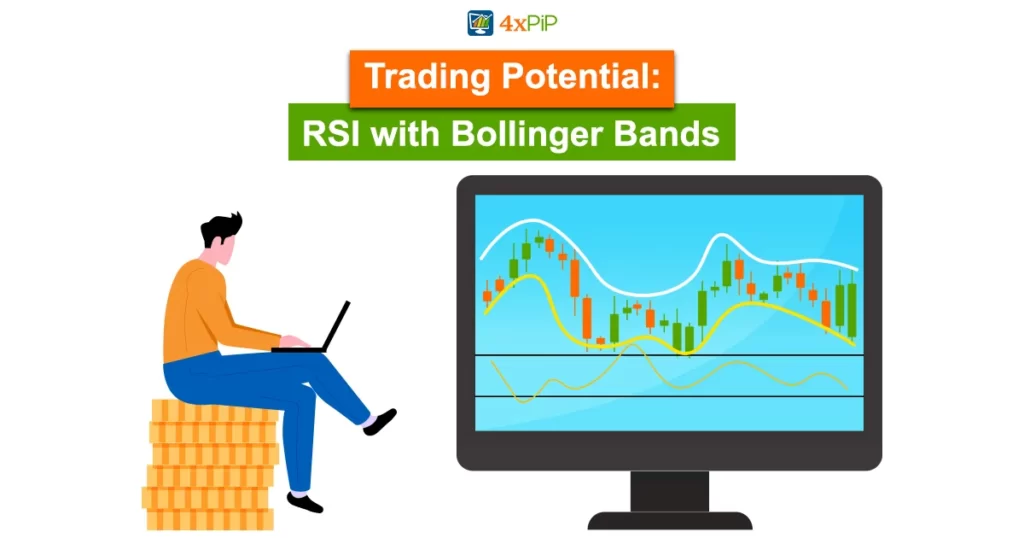Check out our guide on using RSI with Bollinger Bands for better trading. Explore 4xPip’s Indicators and robots for more insights. For expert help, email [email protected]. Elevate your trading with 4xPip!
In trading, using two Indicators together can give us useful insights. Today, let’s look at how the Relative Strength Index (RSI) and Bollinger Bands work together. When we combine them, it’s called “RSI with Volatility Bands.” This combination helps traders find possible market extremes uniquely.
Understanding RSI:
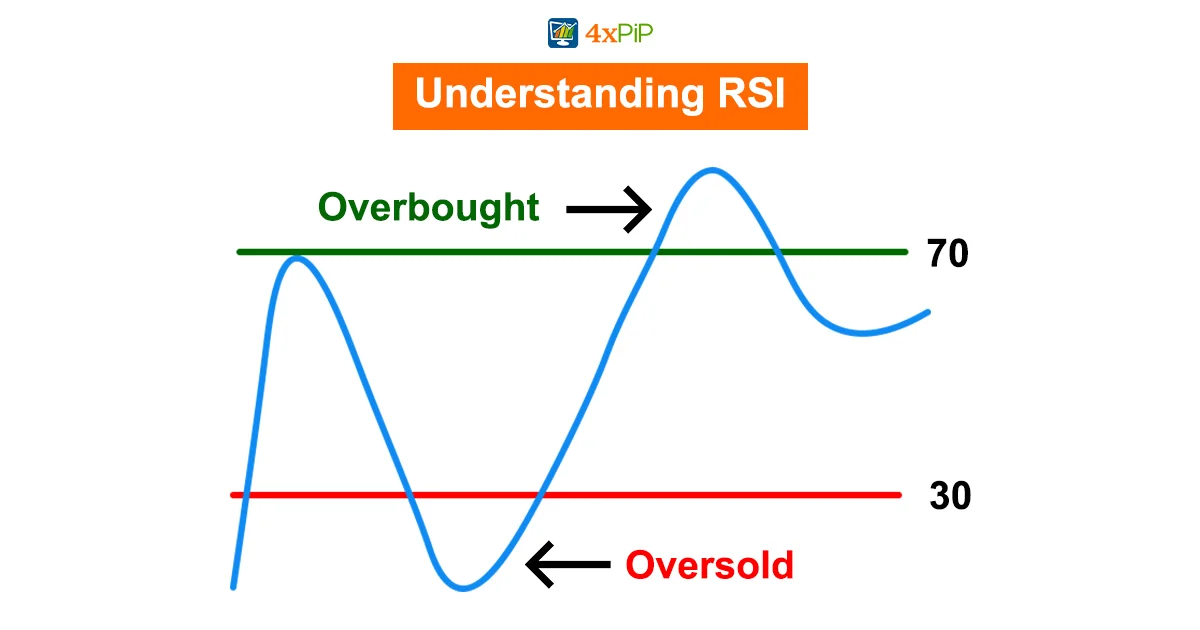
The RSI is like a speedometer for price changes. It was made by J. Welles Wilder to show if the market is too high or too low. The RSI values go from 0 to 100. Traders use it to find good times to enter or leave the market.
Decoding RSI Calculation:
The RSI (Relative Strength Index) is a number calculated with this formula: RSI = 100 – (100 / (1 + RS)). RS (Relative Strength) compares how much the stock gained to how much it lost over a specific time, usually 14 days. If the RSI is over 70, it means the stock might be overbought. If it’s below 30, the stock might be oversold.
Bollinger Bands Unveiled:
John Bollinger created Bollinger Bands, which are bands around an average moving line. They have a middle band (a simple moving average), an upper band (the middle band plus two standard deviations), and a lower band (the middle band minus two standard deviations). These bands show how prices are moving and can signal possible changes in direction.
Cracking Bollinger Bands Calculation:
The three lines in Bollinger Bands involve a simple moving average over 20 periods, the upper band (middle band plus two standard deviations), and the lower band (middle band minus two standard deviations). Bands contract during low volatility and expand during high volatility, aiding traders in spotting breakouts and reversals.
Combination of RSI and Bollinger Bands:
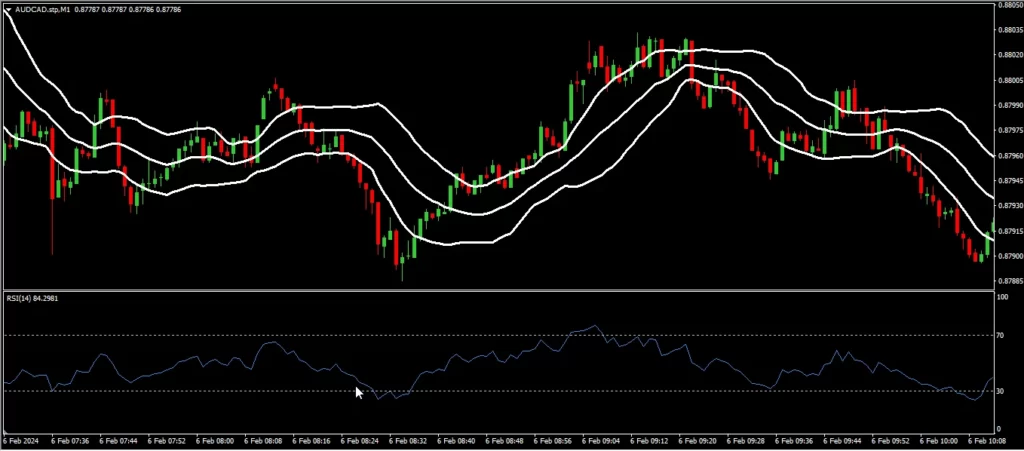
Introducing the “RSI with Volatility Bands” indicator – a powerful tool that combines RSI and Bollinger Bands. It helps traders better understand the market and make smart decisions by giving a clear view of market extremes.
Strategies Using RSI with Bollinger Bands:
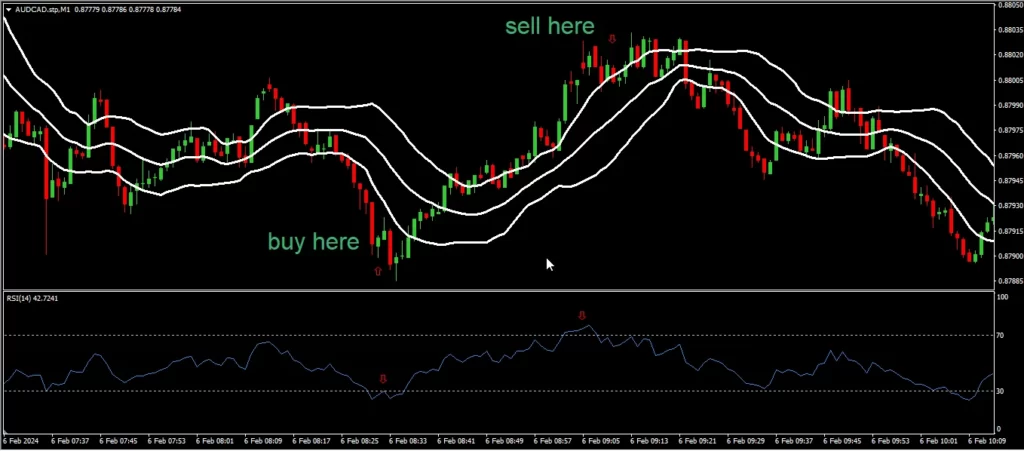
Try different ways to use RSI with Bollinger Bands for trading stocks. Check the market, test buying and selling rules, and see how these strategies can help predict stock movements. Look at Ellen Rohrbacher’s examples like the “RSI/Bollinger #NT” scanner and “RSI/Bollinger Long Strategy #NT” for practical guidance.
To enhance your stock trading, consider purchasing when the RSI exceeds the upper Bollinger Band, indicating potential overbought conditions. Conversely, if the RSI drops below the lower Bollinger Band, it may signify oversold conditions, presenting an opportune moment to sell. Following these signals can help you make more accurate decisions in your stock trading.
MT4 RSI EA:
DOWNLOAD NOWBollinger Band:
DOWNLOAD NOWApplication of RSI with Bollinger Bands:
Using the RSI with Bollinger Bands means paying attention to when the RSI goes above or below the bands. If the RSI goes above the upper band, it could mean the price is too high, and a correction might happen. On the other hand, if the RSI falls below the lower band, it might indicate the price is too low, and there could be a potential increase.
Advantages of the Dynamic Duo:
The RSI with Bollinger Bands indicator presents several advantages:
Enhanced Market Insight: The combination provides a deeper understanding of the market environment.
Improved Signal Accuracy: Bollinger Bands enhance the precision of identifying overbought and oversold signals.
Versatility: Applicable across various markets, including stocks, forex, commodities, and cryptocurrencies.
Tips for Integration:
Maximize the effectiveness of the RSI with Bollinger Bands:
- Confirm trade signals using other technical analysis tools.
- Set appropriate stop-loss and take-profit levels for risk management.
- Test the indicator on historical data before live trading.
- Exercise patience, waiting for clear signals before executing trades.
Limitations and Considerations:
While a powerful tool, the RSI with Bollinger Bands comes with limitations:
False Signals: Mitigate risk by using the indicator alongside other analysis EAs.
Lagging Nature: Both indicators rely on historical data, sometimes leading to delayed predictions.
Conclusion:
In trading, the RSI with Bollinger Bands is a useful tool. It helps traders see extreme market conditions. But, it’s important to use it wisely. Combine it with other analysis tools, and be disciplined in managing risks for successful trading.
FAQs
What is the RSI with Bollinger Bands indicator?
The RSI with Bollinger Bands combines two powerful tools, RSI and Bollinger Bands, to identify market extremes.
How is RSI calculated, and what does it measure?
RSI is calculated using a formula involving average gains and losses, measuring the speed and change of price movements.
Can you explain the components of Bollinger Bands?
Bollinger Bands consist of a middle band (SMA), upper band (middle band + 2 standard deviations), and lower band (middle band – 2 standard deviations).
What are the advantages of using RSI with Bollinger Bands?
The combination enhances market insight, improves signal accuracy, and is versatile across various markets.
How do traders use the RSI with Bollinger Bands indicator?
Traders watch for RSI breaches of upper or lower bands to identify potential overbought or oversold conditions.
Are there practical examples of strategies using RSI with Bollinger Bands?
Yes, strategies like Ellen Rohrbacher’s “RSI/Bollinger #NT” scanner and “RSI/Bollinger Long Strategy #NT” offer practical insights.
What precautions should traders take when using this indicator?
Traders should confirm signals with other technical tools, set appropriate stop-loss and take-profit levels, and test the indicator on historical data.
What limitations come with the RSI with Bollinger Bands?
Using the indicator alongside other analysis tools can mitigate limitations such as false signals and a lagging nature.
How can I leverage the RSI with Bollinger Bands for trading success?
Understand its subtilities, complement it with other technical tools, and maintain discipline in risk management for sustained trading success.
How can 4xPip enhance my trading journey with this indicator?
– Explore 4xPip’s offerings for trading indicators and robots, and contact [email protected] for expert guidance in navigating the dynamic world of trading.

